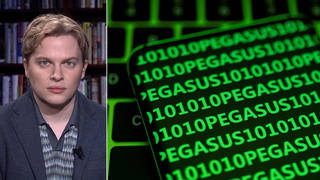
A new report by Amnesty International documents how the Israeli government is using an experimental facial recognition system to track Palestinians and control their movements. The findings are part of “Automated Apartheid,” which reveals an ever-growing surveillance network of cameras in the occupied West Bank city of Hebron and in East Jerusalem — two places in the Occupied Territories where Israeli settlements are expanding within Palestinian areas. “Surveillance has been ramping up as illegal settler activity has also been ramping up,” says Amnesty researcher Matt Mahmoudi, who adds that the surveillance technology is part of an overall coercive structure used against Palestinians by Israel. “Effectively, facial recognition is augmenting, reinforcing, entrenching aspects of apartheid.”
Transcript
AMY GOODMAN: We begin today’s show looking at how the Israeli government is using an experimental facial recognition system to track Palestinians and control their movement. The findings are part of a new report by Amnesty International titled “Automated Apartheid” that reveals an ever-growing surveillance network of cameras in the occupied West Bank city of Hebron and East Jerusalem — two cities in the Occupied Territories where Israeli settlements are expanding within Palestinian areas. The high-resolution cameras are pointed at mosques, hospitals, schools and into people’s homes. In Hebron, a program called Red Wolf is used at military checkpoints to scan Palestinians’ faces and add them to vast surveillance databases without their consent. This is clip from a video accompanying the new Amnesty report.
MATT MAHMOUDI: Imagine you’re a Palestinian person from a small village in the Occupied Territories. You have not registered at a checkpoint or been detained. You have not given your consent to the state. Now, let’s say you go visit a sick family member in Hebron, so you pass through a checkpoint. A little yellow light flashes up on the guard’s screen, but you think nothing of it. But at that moment, that camera has taken a little picture of you and compared it to other images and databases. It hasn’t recognized you, so it’s taken a picture and fed you into a system without your consent. And this feeds into a giant system, so that from now on any checkpoint in the Occupied Palestinian Territories or in Israel know who you are. Scans against other biomarkers, other cameras, other databases, all at a massive scale without your consent.
Now, skip forward to the next time you pass by a checkpoint. You pass through the turnstile, and a border guard you’ve never seen before on the other side says, “Hey, Matt, how are you doing today?” And you realize you’re now in the system. You hope to God that that little light behind the screen doesn’t for some reason beyond your control turn red. That is Red Wolf.
AMY GOODMAN: When Palestinians are detained at checkpoints or elsewhere, their so-called biomarkers are added to the surveillance network. This is another clip from “Automated Apartheid,” featuring Alia Malak, a researcher and adviser on artificial intelligence for Amnesty International.
ALIA MALAK: Israeli security forces started having competitions around who could take the most pictures of a Palestinian to run through the database and see if they could find a match. And it’s been referred to as Facebook for Palestinians. That’s profoundly dehumanizing to be treated as if you’re part of a video game.
AMY GOODMAN: The new “Automated Apartheid” report follows Amnesty International’s major report last year that laid out how Israel is subjecting Palestinians to the crime of apartheid under international law. This is Cambridge University professor Saul Dubow.
SAUL DUBOW: There are, undoubtedly, compelling and very disturbing parallels between the situations under apartheid South Africa and in Israel-Palestine, but I think the differences are also important. The system, oppressive as it was, was never fully operational, and certainly that the sort of high-technology claims or hopes of the apartheid government that a centralized bureau of proof could capture all useful information about Blacks, that this simply couldn’t — that this simply was not sustainable using the technology of the time, however terrifying it would be if you were arrested. This was paper copies; it was not digital. By surviving into this period where digital capacity, artificial intelligence is so much more advanced, that gives the Israeli state far more control.
AMY GOODMAN: The Israeli newspaper Haaretz published an editorial Wednesday in response to Amnesty International’s report, that read, in part, quote, “There is no other way to describe this system except as 'biometric apartheid.' … In the case of Palestinians, not only are they not asked for their consent, the data collection is done without their knowledge,” Haaretz said.
For more, we go to London. We’re joined by Matt Mahmoudi, the lead researcher for Amnesty International’s new report called “Automated Apartheid: Facial recognition entrenches the oppression of Palestinians.”
Matt, welcome to Democracy Now! Can you continue to lay out what you found?
MATT MAHMOUDI: Thank you for having me. Absolutely.
What we found is, effectively, a system of facial recognition, in particular in Hebron, that follows a slew of experimentation with facial recognition technologies against Palestinians, especially in H2, which is under the ruling of the Civil Administration, which is a subunit of the COGAT, really under military rule, so to say. And really, what we’re seeing here is how facial recognition experiments are being used against Palestinians under the auspices of protecting the some 850 Israeli settlers that are illegally present in the area, such that Palestinians who previously relied on, for example, knowing a soldier when they’re passing by a checkpoint now have to rely on an algorithm, that has collected their biometrics without their knowledge and consent, being able to recognize them. And should it not recognize them, they’re suddenly finding themselves in a conundrum in which they might be held back at the checkpoint. A soldier will ask to match their ID to a facial capture that has already been taken, such that they can continue to teach the facial recognition algorithm to recognize them in future.
In East Jerusalem, we see similar trends in which, really, surveillance begets illegal settler activity, and illegal settler activity begets surveillance. We’re seeing how surveillance has been increasing following the crackdowns on the protests that came as a result of the evictions of seven Palestinian families from Sheikh Jarrah in 2021. Here, we’ve seen, in Sheikh Jarrah, in particular, as well as by Damascus Gate, as well as in Silwan, areas that are of profound significance to Palestinian communities, that surveillance has been ramping up as illegal settler activity has also been ramping up. And we’re seeing this as a part of a coercive environment that is meant to force Palestinians out of areas of strategic interest to Israeli authorities.
And that is why we’re saying that, effectively, facial recognition is augmenting, reinforcing, entrenching aspects of apartheid, such as the aspect that speaks to restrictions on freedom of movement, which is the basic right that Palestinians need to have in order to be able to access things such as, you know, housing, education, work, etc., medical care, as well as the coercive environment component, which is instilling a chilling effect on Palestinians and stopping them from being able to resist and introducing a further calculus making it more dangerous to do so.
NERMEEN SHAIKH: Matt, could you explain when this surveillance technology was put into use in the Occupied Territories and whether there’s any indication that Israel plans to expand the use of this technology?
MATT MAHMOUDI: Well, to speak of the two systems, in particular, that we had under investigations, which is to say the Mabat 2000 system, which is a networked surveillance system that’s used in East Jerusalem, and the Red Wolf system, we can speak to, for example, how the Mabat 2000 system was actually put in place at the turn of the millennium. But only in 2017 and 2018, further investment by Israeli police meant that the system was now capable of facial recognition. We initially started with some 400 cameras that were networked, to then now thousands of cameras that are able to connect with one another and perform facial recognition on Palestinians, who at times, we’ve seen, are pulled out of crowds and identified simply for participating in protest. We’ve also seen, in places like H2, in Hebron, the rampant use of facial recognition experiments. Of course, surveillance has been part and parcel of the experience in Hebron since the initial division in 1997 between H1 and the H2 areas of Hebron. But since 2015, in particular, there has been surveillance cameras placed virtually everywhere in streets in H2.
In 2021, we started hearing about reports of an app called Blue Wolf being used against Palestinians in Hebron, where effectively soldiers were raiding homes, picking on Palestinians on the streets, and registering their faces into this database that contained further information on Palestinians, in an effort to automate the process of being able to identify them in future on the streets. The app, Blue Wolf, incentivizes military units for being able to capture as many faces as possible and makes it nearly inescapable for Palestinians to come across surveillance.
Now, Red Wolf is just the latest in a slew of these tools that have been used on Palestinians. And we believe there’s a high risk of the tool plugging into the database that’s already been curated by Blue Wolf, such that information might be presented to a soldier at a checkpoint that really a Palestinian passing through may have no idea exists on them in the first place.
NERMEEN SHAIKH: And, Matt, could you tell us a little about where this technology comes from? The U.S. is reportedly the second-largest exporter of surveillance technology, in particular face recognition technology, and China is the number one exporter. What did you find about the origins of this technology?
MATT MAHMOUDI: While we know that the Mabat 2000 system and the Red Wolf system don’t have an explicit origin in terms of developer as far as the software is concerned, we know about some of the companies that are supplying the cameras, the CCTV cameras, that are plugging into the Mabat 2000 system in places like East Jerusalem. So, there has been a number of reporting done by various partner organizations of ours leading up to this moment, but we found in our report that, in particular, Hikvision, the Chinese surveillance manufacturer, as well as TKH Security, which is a Dutch-owned surveillance manufacturer, are particularly present in East Jerusalem.
Hikvision cameras, especially, seem to be increasing over the last two years alone in tandem with illegal settler activities in Silwan. And I want to point out here that in Silwan, we are seeing biblical excavation projects in the City of David sites followed by settler activity which is taking over demolished Palestinian homes and unhousing them and then inserting surveillance in the areas to further restrict Palestinians from resisting their illegal activity there. So, there, TKH Security and Hikvision, in particular, are at risk of being complicit in international grave crimes, unless they make explicit a plan for the removal of their products and make it clear what their human rights due diligence process as well as business relationships have been with Israeli security forces in the area.
AMY GOODMAN: Matt Mahmoudi, can you talk about the effect this has on the right to freedom of expression, the right of assembly, when you have this kind of surveillance going on?
MATT MAHMOUDI: It’s important to note that Palestinians, of course, are still resisting the occupation. They’re still resisting apartheid. But we’ve seen, in places like Hebron, where Palestinian groups, such as the Youth Against Settlements group, have been effectively under house arrest, with cameras outside turned against their home, making it very difficult for them to engage in their normal activities. In East Jerusalem, we’re seeing Palestinians participating in protests, both following the crackdown on the Sheikh Jarrah evictions, as well as following the killing of Shireen Abu Akleh, being pulled out of crowds and identified. This disincentivizes people and inserts a sort of environment of fear, which makes it very, very difficult, or at least very costly, for Palestinians to engage in protest and resistance.
In Silwan, we had a number of reports from our witnesses and interviewees who spoke to the feeling that every time they have to cross a street, not even to participate in protest but simply to go and grab coffee with someone, with a neighbor, with a family member, they have to think about where the surveillance cameras were. They have to think about what risks they might be incurring in order to participate in just aspects of normal social living. In Hebron, we had testimonies that spoke specifially to how this form of militarization and this form of surveillance has nearly killed all aspects of social life.
NERMEEN SHAIKH: Matt, could you talk about — you’ve also documented the widespread use of a network of CCTV cameras. Could you talk about the links between the use of this facial recognition technology, how that works together with this network of CCTV cameras, and also the effect of now the quite quotidian use of facial recognition technology, for example, in smartphones, which, you know, is now quite widespread?
MATT MAHMOUDI: Absolutely. First of all, to speak to the network surveillance that we’re seeing in East Jerusalem, as I say, the Mabat 2000 system was put into place in 2000, at the turn of the millennium, but it was only equipped with facial recognition technologies in 2017 and 2018. The way that it works is that any camera that is capable of capturing faces, so any high-resolution cameras, which would mean most cameras produced over the last 10 years that are capable of capturing videos, would be able to plug into a software-based system, that sits on a computer, which can effectively run facial recognition on those CCTV cameras, which is also why, in our previous research with Amnesty, we’ve made it very clear that most cities are just one software upgrade away from being able to have ubiquitous facial recognition capabilities. East Jerusalem is no exception to this, except we’re dealing with a context that is internationally recognized as an illegal annexation. And so you’re dealing with a double-edged sword of both having the technology that we see as being fundamentally incompatible with international human rights law, whilst also having it apply in a context that is fundamentally against international law, which is to say the context of apartheid and the context of the illegal annexation.
As for the quotidian nature of facial recognition technologies, it’s important to note the differences between the systems that we’re speaking about here. So, facial recognition that you might find in your phone is what we call one-to-one facial recognition, which is a match that is made upon you having known and consented toward your face being captured and stored locally on your phone for later recognition, such that you can log into your system. You might also think of it as what some call facial recognition for authorization. It is sometimes applied to buildings. You will walk into a space you have already registered just your face to your profile. It will recognize you and allow you entry.
For facial recognition for mass surveillance or facial recognition for identification, what we also call one-to-many facial recognition, we’re dealing with a system that relies on curating a large-scale database without your knowledge and consent, usually scraping millions of images off of, for example, social media, or, just in the context of Hebron, for example, through soldiers going around the streets and taking pictures from Palestinians without their knowledge and without their consent. And those then feed into this database that is then being used together with a facial recognition algorithm that determines who the people that are being displayed in particular CCTV footage are. Now, because these systems depend on this large-scale database, we consider them, by design, to be incompatible with the right to privacy, because they are, by design, technologies of mass surveillance.
AMY GOODMAN: What is the final recommendations of AI for AI — that’s Amnesty International on artificial intelligence — and what you call automated apartheid?
MATT MAHMOUDI: We’re calling for the immediate end to facial recognition technologies, for a ban on the sales, export, development, deployment of the technologies, and, in particular, for companies that are providing tools that can be used for facial recognition to immediately cease the sales of those in the context of the Occupied Palestinian Territories. We also are calling on the state of Israel to dismantle its system of apartheid against Palestinians. And we believe that by stopping facial recognition, we’re taking one step towards weakening apartheid.
AMY GOODMAN: Matt Mahmoudi, we want to thank you very much for being with us, lead researcher for Amnesty International’s new report, “Automated Apartheid: Facial recognition entrenches the oppression of Palestinians.” We’ll link to the report and the 20-minute video that goes along with it.
Next up, we speak to an Afghan women’s rights activist who served in the Afghan Parliament, as well as a Greek refugee advocate who’s trying to help scores of Afghan families, including a group of Afghan women parliamentarians, who have been stuck in Greece for more than a year and a half. Stay with us.











Media Options